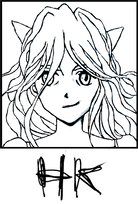HK regularly uses handwriting, letters, and words as means of informing mark making. Thus, this body of work can be associated with Asemic writing. Wikipedia gives a nice description:
“Asemic writing is a wordless open semantic form of writing…The word asemic means "having no specific semantic content", or "without the smallest unit of meaning"…With the non-specificity of asemic writing there comes a vacuum of meaning, which is left for the reader to fill in and interpret. All of this is similar to the way one would deduce meaning from an abstract work of art. Where asemic writing differs from abstract art is in the asemic author's use of gestural constraint, and the retention of physical characteristics of writing such as lines and symbols. Asemic writing is a hybrid art form that fuses text and image into a unity… It may be compared to free writing or writing for its own sake, instead of writing to produce verbal context…”
As the summary might suggest, HK’s paintings vary in their level of asemic quality. This variation is often the result of differences in readability (visible/explicit use of verbal content) and semantic influence (purposeful inclusion of particular verbal content). Put more generally, asemic quality varies according to the precise balance and prioritization of the semantic, symbolic, and aesthetic content present within a given work. The conceptual interest of HK’s ascemic art follows in theme; the work invites consideration of issues related to semantic holism, semantic and syntactic expression, and verbal versus non-verbal expression.
For more on asemic writing, see contemporary poet Jim Leftwich’s work and thematic compilation, and Asymptote's interview with Michael Jacobsen. Additionally, Henri Michaux is a popular figure from the early 20th century. The calligraphic works of Chinese poets Zhang Xu and Huai Su (Tang Dynasty) are also widely credited as being instrumentally influential.
“Asemic writing is a wordless open semantic form of writing…The word asemic means "having no specific semantic content", or "without the smallest unit of meaning"…With the non-specificity of asemic writing there comes a vacuum of meaning, which is left for the reader to fill in and interpret. All of this is similar to the way one would deduce meaning from an abstract work of art. Where asemic writing differs from abstract art is in the asemic author's use of gestural constraint, and the retention of physical characteristics of writing such as lines and symbols. Asemic writing is a hybrid art form that fuses text and image into a unity… It may be compared to free writing or writing for its own sake, instead of writing to produce verbal context…”
As the summary might suggest, HK’s paintings vary in their level of asemic quality. This variation is often the result of differences in readability (visible/explicit use of verbal content) and semantic influence (purposeful inclusion of particular verbal content). Put more generally, asemic quality varies according to the precise balance and prioritization of the semantic, symbolic, and aesthetic content present within a given work. The conceptual interest of HK’s ascemic art follows in theme; the work invites consideration of issues related to semantic holism, semantic and syntactic expression, and verbal versus non-verbal expression.
For more on asemic writing, see contemporary poet Jim Leftwich’s work and thematic compilation, and Asymptote's interview with Michael Jacobsen. Additionally, Henri Michaux is a popular figure from the early 20th century. The calligraphic works of Chinese poets Zhang Xu and Huai Su (Tang Dynasty) are also widely credited as being instrumentally influential.

